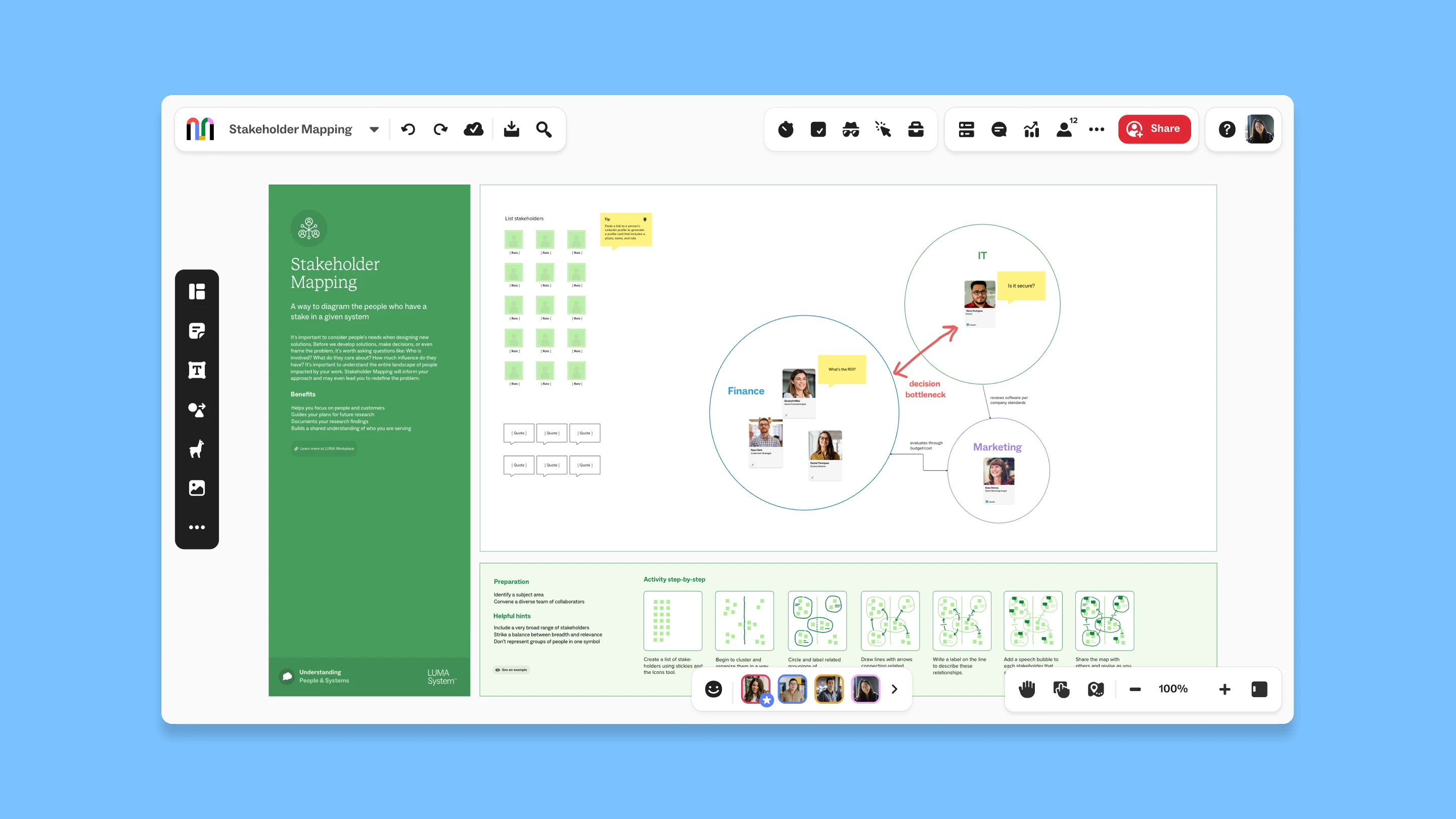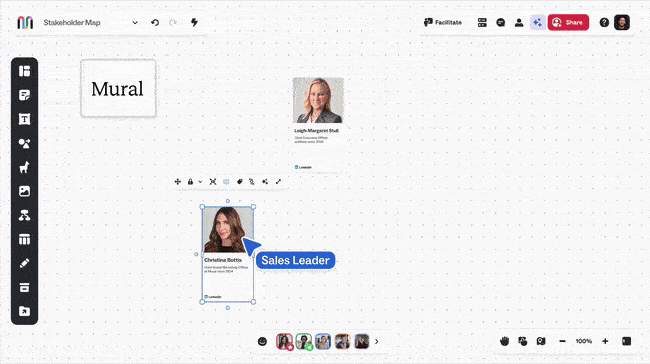On this page
Template use cases
Use Stakeholder Mapping template
Get started
A way to diagram the people who have a stake in a given system

Stakeholder mapping is a critical process for any project or initiative, ensuring that all key players are identified, understood, and effectively managed. The stakeholder mapping template in Mural provides a structured and visual way to organize and analyze your stakeholders, making it easier to align their interests and manage their involvement.
Identify and categorize stakeholders: One of the first steps in stakeholder management is identifying who your stakeholders are. With the stakeholder mapping template, you can list and categorize stakeholders based on their level of influence and interest. This helps you prioritize your efforts and focus on those who can have the most significant impact on your project.
Visualize roles and relationships: The template’s visual layout allows you to map out the relationships between stakeholders, highlighting how they interact with each other and with your project. This visualization can help you understand the dynamics at play and ensure that no important connections are overlooked.
Assess stakeholder influence and interest: Understanding the influence and interest of each stakeholder is crucial for effective engagement. The template includes a matrix where you can plot stakeholders based on these two dimensions. High influence, high interest stakeholders will require more frequent and detailed communication, while low influence, low interest stakeholders might need less attention.
Plan stakeholder engagement strategies: Once you’ve identified and assessed your stakeholders, the template helps you develop engagement strategies. You can outline how you will communicate with each stakeholder, what their needs and expectations are, and what actions you will take to keep them informed and involved throughout the project.

Using Mural’s stakeholder mapping template is straightforward and can be broken down into a few simple steps:
This will form the basis of your analysis and allow your team to assign roles and levels of influence, as all the stakeholders will relate in some way to the central project.
Bring your team together — in real time or asynchronously — to create an exhaustive list of stakeholders related to your central project.
Paste a LinkedIn URL into your mural to instantly create a company profile card. Then, use custom tags and color bars to visually organize stakeholders into categories.

Once you have identified all your stakeholders, have your team select the most critical stakeholders, add a ‘quote’ that helps define their roles within the project, and group them according to their similarities. Use Mural AI to generate, cluster, and summarize next steps faster.
Next, look for relationships between groups, as well as cross-functional connections between individual stakeholders across groups. Map and label those connections with descriptions.
Running a stakeholder mapping template workshop can be a valuable exercise for your team. Here are some tips to ensure it’s a success:
Involve the right people: Make sure to invite team members who have a deep understanding of the project and its stakeholders. This could include project managers, team leaders, and key contributors. Their insights will help you create a more comprehensive and accurate map.
Use Private Mode for sensitive discussions: For discussions that require confidentiality, use Mural’s Private Mode. This feature allows you to take notes and make annotations without sharing them with the rest of the team, ensuring that sensitive information remains secure.
Keep the session interactive: Encourage active participation by using Mural’s interactive features, such as sticky notes and real-time editing. This keeps the session engaging and ensures that everyone’s ideas are captured. Consider using a timer to keep the discussion moving and prevent any one person from dominating the conversation.
Summarize and prioritize: At the end of the workshop, summarize the key takeaways and prioritize the most important stakeholders. Use the template’s notes section to document these priorities and any next steps. This summary will help you stay focused and ensure that your stakeholder management plan is actionable.
Follow up with stakeholders: After the workshop, reach out to the stakeholders you’ve identified to confirm your understanding of their roles and interests. This follow-up can help build trust and ensure that your plan accurately reflects their perspectives. It also provides an opportunity to gather any additional insights or feedback.
The purpose of stakeholder mapping is to identify and understand the various individuals, groups, or organizations that are affected by or have an interest in a particular project or initiative. Stakeholder mapping helps to identify key stakeholders and their relationships to one another, and is often used in the early stages of a project to inform stakeholder engagement and decision-making.
By creating a stakeholder map, project teams can gain a better understanding of the interests, needs, and priorities of different stakeholders, and develop strategies for engaging with them effectively throughout the project lifecycle. Ultimately, stakeholder mapping helps to ensure that projects are designed and implemented in a way that takes into account the needs and perspectives of all stakeholders, and that stakeholders are kept informed and engaged throughout the process.
Identify stakeholders: Create a list of all individuals or groups who have a stake in the project.
Assess influence and interest: Plot each stakeholder on a matrix based on their level of influence and interest in the project.
Map relationships and roles: Visualize the connections between stakeholders and their roles in the project.
Develop engagement strategies: Outline how you will communicate with and involve each stakeholder to ensure their support and alignment.
Over 95% of the Fortune 100 use Mural to get things done.
No credit card required





